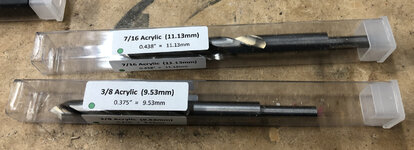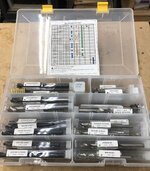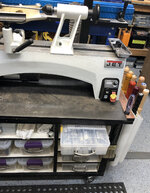egnald
Member
Hello all and greetings from Nebraska!
In addition to the Pen Turning Caddy I use to organize and carry pen parts around my shop, I also made a caddy to organize and store my pen Assembly/Disassembly press and the associated tools that I use along the way. I made this more so I could store all of the associated tools in a designated spot in my shop and move them all in one swoop to the table I use for woodworking and assembly. It also provided a heavy, non-slip holder for my PSI Pen Assembly/Disassembly press which liked to slide around when using it -- the instability also lessening the "feel" of how hard I was pressing when assembling pens.
The entire thing is built out of scrap pieces and cutoffs that I had laying around the shop. I didn't really plan too much, just took empirical measurements and built it on the fly. There is a storage area right under the press for extra disassembly tubing and other bits and pieces and spare materials. On the outside I cut some sides with handles out of 3/4-inch pine and fastened them to a 1/2-inch piece of scrap particle board I had laying around. The dividers and such were just little bits of scrap wood hot glued into place.
It holds my press, a Soft Rubber Barrel Gripper (PSI), along with a set of punches (PSI) and a soft faced mallet for disassembly. (Although the press has tooling for disassembly, I find the aforementioned combination much easier to use - and unlike using the press no setup is required. It also holds a small plastic box of rubber bands and a box of Foundation Wax (that I use to plug the tubes when they are being glued in). Also an assortment of sticks, cotton swabs, some thick CA glue, and a couple cans of wax. On the far end stands some sticks, a Sharpie marker, an insertion tool, a hand reamer, a round rasp, and a round chainsaw file each. There is also a pipe/straw cleaning brush which is handy for cleaning dust and stuff out of the tubes, and a handy tool/gauge that I made for pressing Slimline and Designer NT transmissions in to a precise depth.
The pictures explain it much better than I ever could. - Dave
PS. I put 4 of the large 2-3/8 grip pads from a FastCap TracPad kit on the bottom. With just a little weight these things grab the workbench and keep things solid and amazingly stable. I highly recommend that you check them out along with all of the other wonderful FastCap woodworking products. (I'm not affiliated with them in any way, but I sure do like their stuff!)
Here is how it looks empty (Click on Thumbnails to Enlarge):
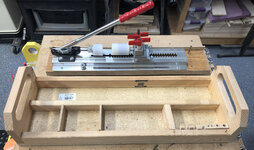
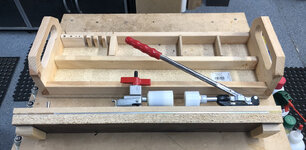
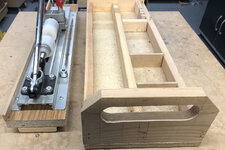
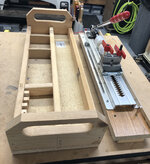
And here is how it looks all loaded up:
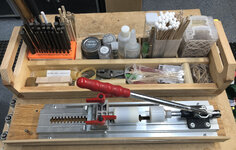
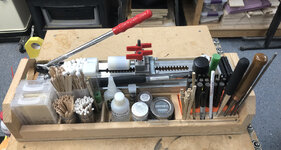
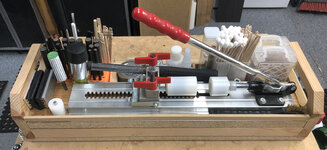
In addition to the Pen Turning Caddy I use to organize and carry pen parts around my shop, I also made a caddy to organize and store my pen Assembly/Disassembly press and the associated tools that I use along the way. I made this more so I could store all of the associated tools in a designated spot in my shop and move them all in one swoop to the table I use for woodworking and assembly. It also provided a heavy, non-slip holder for my PSI Pen Assembly/Disassembly press which liked to slide around when using it -- the instability also lessening the "feel" of how hard I was pressing when assembling pens.
The entire thing is built out of scrap pieces and cutoffs that I had laying around the shop. I didn't really plan too much, just took empirical measurements and built it on the fly. There is a storage area right under the press for extra disassembly tubing and other bits and pieces and spare materials. On the outside I cut some sides with handles out of 3/4-inch pine and fastened them to a 1/2-inch piece of scrap particle board I had laying around. The dividers and such were just little bits of scrap wood hot glued into place.
It holds my press, a Soft Rubber Barrel Gripper (PSI), along with a set of punches (PSI) and a soft faced mallet for disassembly. (Although the press has tooling for disassembly, I find the aforementioned combination much easier to use - and unlike using the press no setup is required. It also holds a small plastic box of rubber bands and a box of Foundation Wax (that I use to plug the tubes when they are being glued in). Also an assortment of sticks, cotton swabs, some thick CA glue, and a couple cans of wax. On the far end stands some sticks, a Sharpie marker, an insertion tool, a hand reamer, a round rasp, and a round chainsaw file each. There is also a pipe/straw cleaning brush which is handy for cleaning dust and stuff out of the tubes, and a handy tool/gauge that I made for pressing Slimline and Designer NT transmissions in to a precise depth.
The pictures explain it much better than I ever could. - Dave
PS. I put 4 of the large 2-3/8 grip pads from a FastCap TracPad kit on the bottom. With just a little weight these things grab the workbench and keep things solid and amazingly stable. I highly recommend that you check them out along with all of the other wonderful FastCap woodworking products. (I'm not affiliated with them in any way, but I sure do like their stuff!)
Here is how it looks empty (Click on Thumbnails to Enlarge):




And here is how it looks all loaded up:




